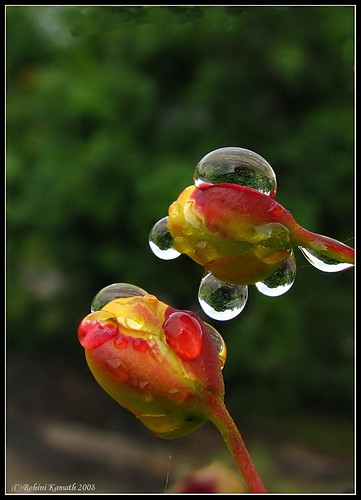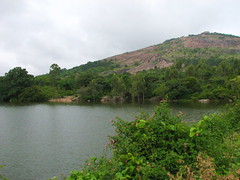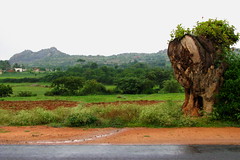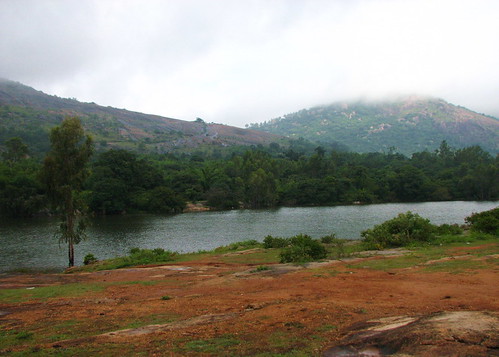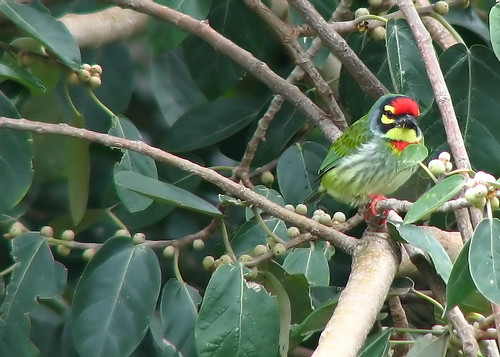The following rituals are combined after deep research from a book "Reethi Rivaz" (in Kannada) and from interogating our Pandit and relatives several times.
Wedding Rituals
On the morning of the wedding, the Pandit will arrive at the brides house and conduct a small prayer for proceedings to go smoothly. Elder relatives of the brides parents are usually also invited to this early morning prayer session.
After brief prayers, the bride touches the feet of all elders present and the wedding party proceeds to the hall. The Bride has to wear a not too grand sari (Sari 1) which need not even be new. ( The idea apparently is to keep expenses in control )
Inviting Groom's Party
The Brother of Bride / Maternal Uncle (Mama) of the bride will go to groom's house and invite the groom's family to the hall.
He will take with him a box of sweets (previously used to be a box of homemade laddus), flowers for the women of the house and token cash (in envelopes) for any small children of the groom's family.
Edur Kansani ( Receiving the Groom's party )
Once at the hall, bride's party prepares to receive the groom. This program involves only women.
The women will wait outside the hall with the paraphenelia as described. The Brides sister or Paternal cousin sister will hold a circular steel plate (thali/poleru in konkani) (Plate 1) it will have the following
1.Mirror supported by a Kalash ["tambio"(in konkani for a copper pot) with water and a coconut on it]
2.Gold chain set on the mirror
3.Flower garland on the mirror
4.Kumkum and Haldi in bowls
5.Raw Rice
Plate 2 with another sister will have flowers and a Rose Water dispenser
(Gulab-dani, usually made of Silver), Plate 3 with yet another sister will have 4 coconuts on it.
Plate 4 with folded Paan with supari (Veedo).
When the groom's party arrives, the women of the family will precede the men to the entrance. The Groom's sisters will hold Plate 1 (just as in the brides side) and Plate 3. Plate 2 and Plate 4 can be shared.
The women will now walk towards each other and apply kumkum and haldi to each others foreheads and wear a flower from Plate 2. They will sprinkle rose water on each other.
Entering the Hall
Before entering the hall, a aarti of kumkum water is given to groom. This done,
the father of the bride will give the Groom a coconut in his hand and put a small garland around his neck in greeting and lead him by the hand (lest he runaway) into the hall and seat him in a chair in the hall. Rest of the party will follow.
Phool Muddi ( The Flower and the Ring )
Along with the groom sits an un-married boy who is called "Dhedo" (previously the dhedo would be a young kid, nowadays young eligible bachelors are seated instead as a way to get noticed).
Once the groom is captive in the chair, his feet are washed by the father of the bride. A Gold Ring is placed on his finger. A new sacred thread is put on him (over this clothing), he will already have one of his own under it. A Peta is placed on his head.
Aarti is done to him by the bride's mother (with cloth wicks not cotton) and rice is sprinkled on him.
He is fed 5 different types of sweets and a sip of sweetened milk. The Dhedo gets a gift of clothing.
Now, its the brides turn. Bride makes her first enterance to the gathering (still in Sari 1)and is seated in the chair. Along with her sits the "Dhedi" (female version of the dhedo)
She is gifted a Sari and any other gifts (usually ornaments) from the groom's mother. Flowers (white managlore mogra) is pinned to her hair. Aarti is done to her by the groom's mother (with cloth wicks not cotton) and rice is sprinkled on her. She is fed 5 different types of sweets and a sip of sweetened milk. Like the Dhedo, the Dhedi gets a gift of clothing also.
Breakfast I
The first breakfast is served and the whole party tucks in. Bride changes clothes. Brides mother can also change. ( So can anyone else, there is no hard and fast rule)
Ghade Udhak ( Water clock )
Originally intended to help the gathering keep track of the time, now it is done only for symbolic purposes.
5 thambios (copper pots) are held, one each by five women namely bride, bride's mom, groom's mom and 2 others.
They are filled with water and Ganga Pooja is performed as instructed by Pandit.
These pots are then kept aside to be revisited later.
Udida Moorth (Grinding of Gram)
A mix of Green Gram, Black Gram (Udid in konkani), tumeric, oil is prepared and the bride (now in Sari 2) and her mother jointly grind it in a manual stone grinder. Not sure of the significance, if anyone has an idea, pls let me know. Further minor rituals are perfomed as instructed by pandit.
Once the bride is done grinding, her party proceeds to Breakfast II. Vacating the seats to allow the groom and his sister(s) to do the grinding too. The sisters also get to apply kajal to the groom.
Grinding can be done simultaneously also if there is equipment and space available.
Kaashi Yatra
Tired of all the rituals, the groom decides to renounce worldly life and meditate in Kaashi. He sets out with an umbrella, and a Potli ( cloth tied into a bag on a stick containing his worldly belongings ). He is stopped by the Father of the bride, who tells him of the virtues of married life. (Mostly he tells him, there is no escape now, you're doomed)
Once again captive, the groom is pacified with a gift either of money or a gift of clothing and an aarti and proceeds to Breakfast II. He can change his clothing also.
"Go Daan" (Gift the pandit a cow)
Traditionally at this point, the pandit performing the rituals is given a cow as a gift. Now a days ofcourse this is symbolic and cash and/or clothing is given instead.
Aarti is now done to the Groom's Sisters, Groom and the Dhedo and they make a pradakshina (walk in a circle around) the Homa Kund (central holy fire place).
The Water clocks/ Ghade Udhak is revisted by the 5 ladies to check if the water pots are hale and hearty.
Breakfast II
The second breakfast is served and all tuck in (again!)
Entering the Mantap
The bride now well fed and covered in mounds of silk, flowers (moggina ja-day - jasmine flower headress) and a ton of gold is led into the Mantap by her mother. Meanwhile, the Pandit does a pooja of the Mantap. She enters the mantap with her right foot first.
The Dhaare Mani ( black bead and gold chain with 2 large coral beads ) is Mangalsutra 1. It is given by the bride's family. The chain is taken around the hall to be blessed and inspected by the elders.
After remembering the family diety, it is put around the brides neck by her Mother. An aarti is done to her and rice is liberally sprinkled over her.
This done, the bride is dispatched away again, possibly to be decked with more gold.
Var Pooja
The Bride's married sisters and their husbands are called into the mantap in sequence and given a gift of clothing, aarti and rice sprinkling.
Groom Bashing! ( tying the "bashing" on the turban )
"Bashing" is an ornament made of thermocol and glitter held together by glue. It has lot of dangling beads and shiny papers stuck to it. Hideous though it is, it is tied to the Turban of the Groom. Traditionally it was tied over the Gandhi cap which was worn by the groom. It is a good idea to tie it out of sight behind the fan of the peta so that it is not seen.
Preparing the "Talee" ( Thali or Plate )
1 Plate (Vothu Ghadi - means "at the time of pouring" ) is prepared and held by the mother of the bride. It contains the following:
1. 2 simple non zari saris (meant for daily wear by the bride in her new house)
2. Paan Veedo
3. Flowers and Raw Rice
4. 1 Coconut, sari blouse piece, kunkum ( collectively called Vonti )
Plate 2 ( Lagna Talee - wedding plate ) is prepared and held by Groom's mother. It contains the following:
1. Post Wedding Sari ( a grand sari nowadays worn at the reception)
with Pallu visible (pallu has to be visible for aunties present to estimate the cost of the sari :D )
2. Mangalsutra 2 - Chunky Gold and coral bead chain.
3. Paan Veedo
4. Mogra Flowers and Raw rice
5. Silver Kunkum Box
6. A small box of Kajal
7. Ivory comb ( now replaced by a plastic imitation)
8. "Bashing" ( for the bride this time )
The Pandit now does a pooja of the Plates as above. The father of the bride brings the groom into the Mantap along with the Dhedo.
The Plates mentioned above are carefully placed under his chair.
Once he is seated, the parents of the bride will perform an aarti, arghya padya (feet washing) and then put a sacred thread for him. He is given a gift. The gift is usually a Sandook ( if not available, cash is used). A Silver Sandook set ( consists of a plate, a small glass, spoon, box to hold religious stamps, the stamps and a thambio (silver pot) these items are to be used for daily pooja )
Anthar Paat (Curtain)
A cloth is now held by two pandits to obscure his view, because the bride will be brought into the hall now and he should not be able to see her.
Here comes the Bride
The maternal uncle of the bride will bring in the decorated bride leading her by the thumb and will walk her down the aisle from the front enterance of the hall. If there are two they can bring her together (she has only 2 thumbs) . If there are several uncles, a sort of relay is done. Traditional music is played by the musicians and the pandits will commence chanting the mantras.
She enters the mantap again with her right foot and her uncle will sprinkle rice on her head and leave her inside. Now as per instructions by the pandit the Garland exchange between bride and groom takes place.
Dhaar Votuchain (Pouring the stream of milk)
also called Kanya Daan ( Giving away the bride )
A silver pot with a gold pendant of laxmi with a coconut placed over it and milk is poured from it on the hands on the bride, groom and several others as per the instructions of the pandit.
The laxmi pendant signifies that they are giving away the girl only and not the goddess of wealth.
Tying the knot
The Mangalsutra from Plate 2 is retrieved and tied around the brides neck. The "bashing" for the bride is now tied on her head. Plate 2 (Lagna Talee) is given to her. Aarti is done and Rice is sprinkled over her as a blessing.
Kankana (Tumeric pieces) are tied to the wrists of the bride and groom. The coals are fetched by the bride's mother to start the fire in the Homa ( sacred fire ). She is gifted by the grooms family for her efforts.
Lye Virkachain ( Pouring puffed rice )
While the fire is being started, the uncles and brothers of the bride will pour puffed rice through their hands until it falls onto a plate held below. The youngest among them will receive a gift called a Lye Shawl ( now a shirt piece )
The Maternal Uncle will place 2 pairs of toe rings to the bride's toes.
7 Pheras
The bride and groom take 7 circles around the fire as per instructions by the pandit.
Going Bananas!
Bride and Groom now feed each other with Bananas.
Var Ubharchain ( lifting )
The uncle and aunt will then attempt to physically lift the bride and groom. (a daunting task!)
Incase this is not feasible, Bride and groom are walked 4 steps forward and 4 steps back by the maternal uncle and aunt or just gently nudged. The 2 pairs are now given an aarti by the other elders present.
Sharage Ghalchain ( Putting the Pallu )
The mother of the bride will now place the pallu for the bride as a symbol of marriage and replace her half moon bindi with a full moon. The groom will tie a five rupee coin (symbolizing this savings) to the pallu of the bride.
Going Bananas again
Bananas are cut up into small pieces and the bride serves them to the groom's family and her own (symbolizing that she has cooked for them). She is given a gift of cash for her troubles.
Keeping the Name
Traditionally the bride would have a new first name after marriage. The name is still kept, but not used. The mother of the groom will whisper a name 5 times into the bride's ear.
Vonti borchain
The mother of the bride will give her a blouse piece, coconut, kumkum and sprinkle rice for the first time as a married lady.
Baagil Dhorchain
The sisters of the groom, unhappy that their brother will forget them once he is married; will stop him from leaving the mantap. They are pacified with a gift of cash from the Groom.
The wedding party proceeds for Lunch.
